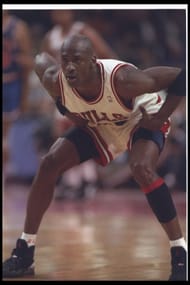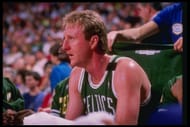Before making their debuts as professionals, elite-level athletes have to show their worth. Historically, for NBA players that was done by playing college basketball. Some of the league's all-time greats had similar NCAA trajectories.
NBA legends, including Michael Jordan, Bill Russell, Kareem Abdul-Jabbar, Magic Johnson and more left a legacy for their schools.
Let's look at the 10 best college basketball players who left their marks on college basketball history.
Top 10 best College Basketball players of all time:
#10, Jerry West, West Virginia University
Jerry West, famously known today as the NBA logo, had a spectacular run in his college days. After receiving multiple offers from schools when he was 18, West decided to attend West Virginia. He played three seasons, earning multiple awards.
In his freshman year, West put up 17.8 points and 11.1 rebounds per game while shooting 49.6%.

From then on, his performance would only skyrocket, as West led his team to the national final.
In 1958-59, as a junior, West averaged 26.6 ppg and 12.3 rpg, making the consensus first team. Entering his senior year, West had his last chance to win an NCAA title. Alhough Mr. Clutch had another dominant season, averaging 29.3 ppg and 16.5 rpg.
He was picked by the Minneapolis Lakers with the No. 2 pick in 1960.
#9, Tim Duncan, Wake Forest
Tim Duncan was determined to graduate from college, earning his degree in psychology. He played four seasons for the Demon Deacons, earning numerous awards, although he missed an NCAA title.
Duncan struggled to find his rhythm in his freshman year, averaing 9.8 ppg and 9.6 rpg.

Things would start to take a turn in sophomore year when Timmy teamed with Randolph Childress, and the duo led Wake to the Sweet 16.
Duncan improved his game, still focused on finishing college, despite having the opportunity to enter the NBA draft each year.
In his senior year, Duncan was named the Defensive Player of the Year for the third consecutive time and also first-team All-Atlantic Coast Conference.
He was the No. 1 pick in the 1997 draft, selected by the San Antonio Spurs.
#8, Shaquille O'Neal, LSU
The Diesel was a dominant force in his college days.
Studying business at LSU, O'Neal set the tone of his game in his freshman year, averaging 14.0 ppg and 12.0 rpg on 57.0% shooting. He went on to put up 27.6 ppg and 14.7 rpg in his sophomore year.

O'Neal put up similar numbers in his junior year before declaring for the draft. Shaq was a two-time consensus All-American and also was on the Southeastern Conference All-Defensive team twice before being the No. 1 pick in the 1992 draft.
#7, Wilt Chamberlain, Kansas
Wilt Chamberlain was an athletic freak. Not only did he put up monstrous numbers, but he was also the reason for new rules that were introduced in college basketball. The 7-foot-1 center received around 200 college offers before joining Kansas, leading his team to a championship game in his first year.
Although they fell short of victory, Chamberlain finished with 29.6 ppg and 19.0 rpg.
In his sophomore year, Chamberlain put up 30.0 ppg and 17.5 rpg. Chamberlain finished his college career as a two-time consensus All-American and was the NCAA Tournament Most Outstanding Player as well.
#6, Oscar Robertson, Cincinnati
Oscar Robertson had a unique college basketball career. The Big O set multiple NCAA records and won scoring titles in all the years he played.
Robertson put up 35.0 ppg and 15.0 rpg in his freshman year. Robertson led the Bearcats to two Final Four appearances while leading the Cincinnati Bearcats in points as well as rebounds.

He finished his college career, averaging 33.8 ppg and 15.2 rpg, being a three-time consensus All-American. Robertson had 10 triple-doubles in his college career, which is still the most in school history. After his three-year stint with the Bearcats, Oscar was selected by the Cincinnati Royals in the 1960 NBA draft.
#5, Michael Jordan, North Carolina
Michael Jordan, the GOAT, was a top recruit coming out of high school and played under Dean Smith in North Carolina. Things started off well as Jordan led the Tar Heels to a national championship in his first year after sinking a game-winning jump shot against Georgetown in the final. The game-winner cemented his name among top-tier players, with MJ already having won the ACC Rookie of the Year award.

Jordan had a great season in his sophomore year, averaging 20.0 ppg and 5.5 rpg. Following his junior year at UNC, Jordan had the Naismith Award, was a two-time Consensus All-American and had awards pouring in to decorate his college career. His athleticism was one of a kind, and Jordan was one of the most consistent scorers.
MJ was the man in the papers, and his popularity grew with time. He was drafted by the Chicago Bulls in 1984.
#4, Magic Johnson, Michigan State
Magic Johnson chose nearby Michigan State over UCLA, which was the top school for playing college sports at the time.
In his freshman year, Magic led the Spartans to the Elite Eight. Johnson averaged 17.0 ppg, 8 rpg and 7.4 assists. The Spartans finished 25-5, as the future was bright. Johnson had excellent court vision and was able to involve his teammates.

Magic put up similar numbers in his sophomore year, although this time, led his team to the NCAA final, where he met his future NBA rival, Larry Bird. Playing against Indiana State, Johnson helped the Spartans be crowned as NCAA champions. Magic was named the Most Outstanding Player and consensus All-American. He then declared for the 1979 draft and was the first pick.
#3, Larry Bird, Indiana State
Larry Bird was a pure scorer with consistent shooting performances, leading Indiana State to the NCAA final. In his freshman year, Bird put up an insane 32.8 ppg and 13.3 rpg while shooting 54.4%. In his sophomore year, Bird put up 30.0 ppg and 11.5 rpg.

He was already a consensus All-American, although a title was missing from his trophy case. In 1979, Bird led his team to the NCAA final and won the Naismith Award as a junior after not signing with the Celtics. Larry was the sixth pick in the 1978 draft, but instead chose to play his final season with the Sycamores. He signed with Boston before the 1979 draft.
Bird went up against Magic Johnson in the final but had a bad shooting night.
#2, Bill Russell, San Francisco
Bill Russell was yet another player who forced NCAA rules changes despite not receiving any offers until a recruiter from the University of San Francisco watched him play. At first, Russell didn't leave a great impression, but his passion for the sport was visible.
Russell teamed with future NBA player, K.C. Jones. In his first year, Russell put up decent numbers, although what was to come was even more incredible.
Russell, alongside Jones and Hal Perry, won the NCAA title in 1955. Russell led the team, averaging 21.4 ppg and 20.5 rpg in his sophomore year. His run didn't end there, as USF won another title in 1956.
His athleticism was one of a kind, being a center while having the agility of a guard. Bill was drafted by the St. Louis Hawks in 1956 as the second pick.
#1, Kareem Abdul-Jabbar (Lew Alcindor), UCLA
Kareem Abdul-Jabbar, originally known as Lew Alcindor, showed great similarities to Wilt Chamberlain before his college days. The 7-foot-2 center chose to play for UCLA. The Bruins were the most recognized college basketball team at the time. Playing for such an institution, Alcindor had no jitters in his first year, as a sophomore.
Abdul-Jabbar averaged 29.0 ppg and 15.5 rpg in his sophomore year. He started off with a 56-point performance. He led the Bruins to a perfect record and a national title as well.
In his sophomore year, Abdul-Jabbar was as dominant, leading UCLA to yet another title.
In the three years Abdul-Jabbar played for the Bruins, the team won 88 games, while only losing two. In 1969, Abdul-Jabbar led UCLA to its third straight title. Abdul-Jabbar finished his college career, averaging 26.4 points and 14.7 rebounds, declaring for the NBA draft as the first pick in 1969.
Baylor vs Duke basketball injury report and predictions, March 23: Latest on Cooper Flagg, Langston Love and more
